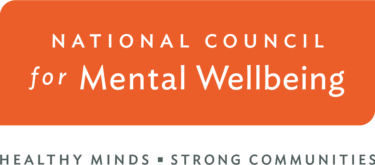September 8-14 marks National Suicide Prevention Week, an annual campaign to educate the general public about suicide prevention and the warning signs of suicide. Here are some resources and learning opportunities to help you do that now and throughout the year.
Talking Suicide Prevention with Kevin Hines

In 2000, two years after he was diagnosed with bipolar disorder, Kevin Hines attempted suicide by jumping from the Golden Gate Bridge. The fall broke his body, but not his spirit. On Wednesday, Sept. 11, we sat down with the global mental health and suicide advocate to discuss his experiences, suicide prevention and the art of living mentally well. Hear Kevin’s story in his own words by watching the newest episode in our Wellbeing Wednesdays virtual learning series.
For Immediate Help
If you or someone you know is experiencing a mental health crisis, call or text 988 immediately, text TALK to 741741 or chat with the 988 Suicide & Crisis Lifeline at 988lifeline.org.
Suicide Prevention Tools and Resources
Organizations across the country are stepping up to provide suicide prevention resources throughout the month. Help raise awareness by taking advantage of the following:
- Show your support during National Suicide Prevention Month, National Suicide Prevention Week and World Suicide Prevention Day (Sept. 10) by downloading and sharing resources from the National Institute of Mental Health (NIMH).
- Educate yourself and others about suicide prevention by downloading resources from the Substance Abuse and Mental Health Services Administration (SAMHSA).
- Positive social connections have been identified as an important protective factor for suicide. Learn how you can #BeThere for others from the Action Alliance.
- Download a two-page resource from the Suicide Prevention Resource Center to learn how anyone, anywhere, can get involved in Suicide Prevention Month.
- Read the U.S. Department of Health and Human Services’ 2024 National Strategy for Suicide Prevention and take steps to implement it in your community.
Opportunities for Impact
The National Council is offering content and learning opportunities to support suicide prevention and mental wellbeing. Here are a few ways you can get involved:
- Register for our webinar, Three Crucial Factors in Treating Suicide Risk: Lessons Learned from the Interpersonal Theory of Suicide, on Sept. 12 (1-2 p.m. ET).
- Get trained in Mental Health First Aid to learn how you can help someone who is developing a mental health problem or experiencing a mental health crisis.
- Learn how to strengthen crisis response in your community by joining the National Council’s Crisis Response Interest Group, a National Council member benefit.
Stand Up for 988: No Judgment. Just Help.
Two years ago, the National Suicide Prevention Line transitioned to the 988 Suicide & Crisis Lifeline. Since then, the number has resulted in more than 10 million contacts and countless lives saved. Here’s how you can help 988 reach more people:
- Learn about 988 Day (Sept. 8), a new SAMHSA-led initiative to raise awareness about 988 and emphasize the importance of mental health and suicide prevention.
- If you plan on doing something on 988 Day, let SAMHSA know by using #988Day on social media and they’ll post it to their activity wall to highlight your support.
- As we enter the third year of 988, write to your Representatives and Senators and ask them to support improvements to the nation’s crisis care system.
- Help us urge Congress to improve 988 and crisis care by routing 988 calls based on general location instead of the phone’s area code, and to expand the ability of local centers to provide crisis care and follow-up services in every community.
Did you know that Certified Community Behavioral Health Clinics (CCBHC) are expanding access to crisis care in communities across the country? Learn more:
- CCBHCs offer comprehensive crisis care at every step of the way, offering someone to talk to, someone to respond and a safe place for help.
- A growing number of CCBHCs are directly connected to the 988 Suicide & Crisis Lifeline. In fact, 42% of CCBHCs partner with 988 call centers to dispatch mobile crisis teams.
- Find out more about CCBHCs in your community!
